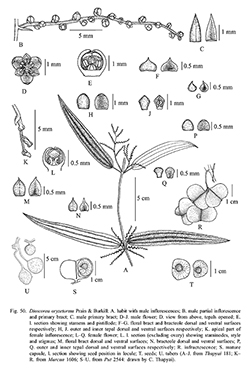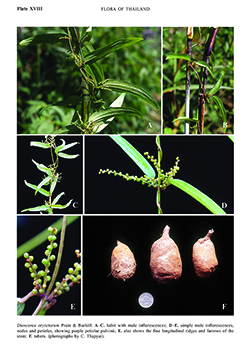e-Flora of Thailand
Volume 10 > Part 1 > Year 2009 > Page 91 > Dioscoreaceae > Dioscorea
27. Dioscorea oryzetorum Prain & Burkillwfo-0000393149
Bull. Misc. Inform. Kew 1927: 242. 1927; Prain & Burkill in Fl. Indo-Chine 6: 742. 1934; Ann. Roy. Bot. Gard. (Calcutta) 14(2): 363. 1938; Burkill in Fl. Mal. 4, 3: 326, 1951; Hô, Câyco Viêtnam 3, 2: 931. 1993; Wilkin, Thapyai & Chayamarit, Kew Bull. 62: 253. 2007. Fig. 50; Plate XVIII.
Accepted Name : This is currently accepted.
Synonyms & Citations :
Description : Climber to 4 m. Tubers often 2–3(–5), to at least 50 cm long and 3–7 mm in diam., spreading, cylindric with thickened 1.8–3.2 by 1.8–3 cm globose to capitate apices and short side branches, annually replaced, subtended by a woody crown. Indumentum absent, white waxy coating absent. Stems 1.5–2.5 mm in diam., twining to the right, annual, unarmed, with fine longitudinal ridges and furrows most easily seen near the nodes in herbarium specimens. Leaves simple, opposite, blades narrowly lanceolate to elliptic-oblong, 3-veined, chartaceous, margins entire, base obtuse to rounded, apex acute to acuminate; petioles 0.7–2.7 cm long; cataphylls, bulbils and lateral nodal organs absent. Inflorescences spicate, pendent, tepals inserted on discoid torus, free, erect, fleshy in texture with inner whorl tepal often thicker than outer; male inflorescences simple or compound, compound inflorescences 1(–2) per axil, simple/partial inflorescences 1–5 per axil, peduncles 1.5–5 mm long, axes 1.1–4.4 cm long; female inflorescences simple, 1(–2) per axil. Male flowers with outer tepals 0.7–1.5 by 0.7–1.2 mm, ovate to narrowly obovate, inner tepals 0.6–1.4 by 0.5–0.9 mm, obovate, margins thickened, especially towards apex; stamens 6. Female flowers as in Fig. 50L–Q. Capsules as in Fig. 50R, S, 10–12 by 21–24 mm. Seeds 2.5–4 by 3–4.5 mm, lenticular-ovoid, wings 10.5–13 by 9.5–11.5 mm, extending all around seed margin.
Thailand : NORTHERN: Phitsanulok (indigenous population and tubers cultivated at Bangkhathum, originally from Nakhon Sawan, Bang Khlong Nong Lek); CENTRAL: Krung Thep Maha Nakhon (Bangkok) (Khlong Rangsit), Ang Thong; SOUTH-EASTERN: Sa Kaeo (Aranya Prathet), Chanthaburi (Wat Sing – type: Kerr 9347, lectotype -K, isolectotypes -AAU BK BM).
Distribution : Laos.
Ecology : Growing in well-drained soil in open areas and hedgerows near rice fields and other cultivated areas, 0–200 m alt. Flowering: September–November; fruiting: October–January.
Vernacular : Man nok chin (มันนกจีน)(Nakhon Sawan); man nok (มันนก)(Ang Thong); man thian (มันเทียน)(Sa Kaeo).
Uses: Some races are cultivated for their edible tubers which are usually peeled and eaten boiled.
Conservation Status: IUCN red list category EN c2a(i) (IUCN 2001). There are c. eight populations of this species known, but only two collections have been made since 1940. Many of the old collecting localities are now parts of greater urban Bangkok. The population in Phitsanulok appeared in 2004 to consist of just two male plants. Conservation measures are needed urgently, including cultivation of the species at a botanic garden in central or south east Thailand.


